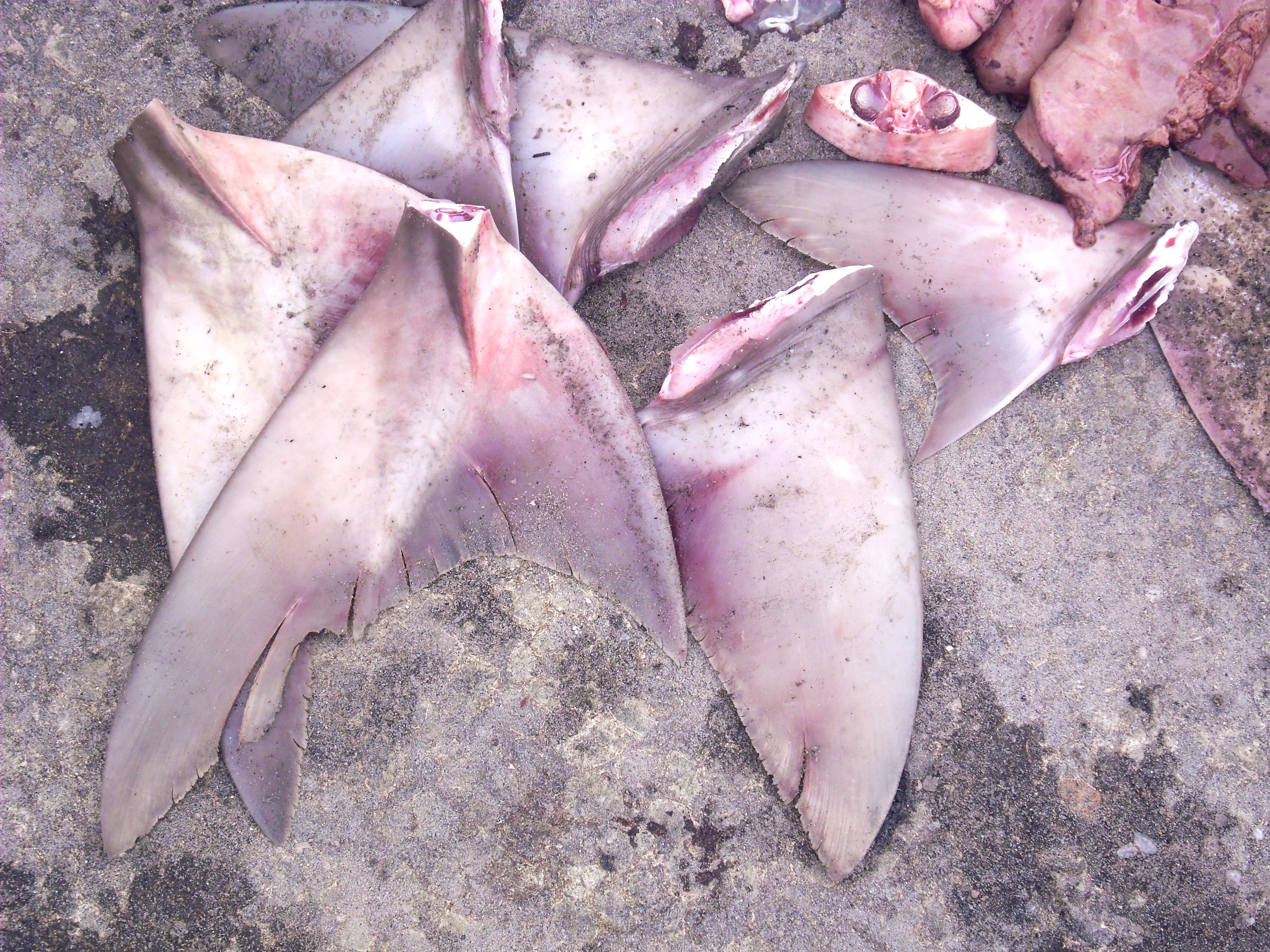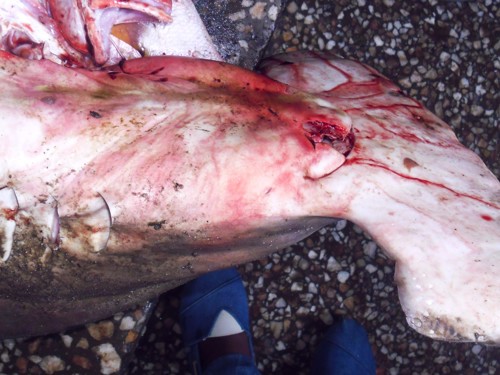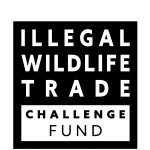Mitigating illegal trade in sharks and rays

The fins of a bottlenose wedgefish, Rhynchobatus australiae, after removal from the carcass at a landing site in East Africa – separated from the carcass to enter a separate value chain. Fins from this species of “shark-like ray” fetch some of the highest prices in the global fin trade. This species is Critically Endangered and listed on CITES Appendix II. Credit – Wildlife Conservation Society.
Sharpening skills to mitigate illegal trade in sharks and rays in Mozambique and Tanzania
Sharks and rays occupy a diversity of aquatic habitats around the world, from the deep sea to coral reefs, and certain species can even be found hundreds of kilometres up rivers in purely freshwater environments. There are over 1,200 known species of sharks and rays globally, and they play diverse and important ecological roles. Some species act as apex predators (the top of the food chain) and others as mesopredators (the middle of the food chain – where they function as both predator and prey).
Regardless of their position in the food web, every shark and ray species plays an important role in its ecosystem. A significant decline in its population size – or full removal – would disrupt the functioning of that ecosystem and have negative consequences both on the other species in that environment (food and predators) and on humans who depend on these marine resources for their sustenance and livelihoods.
"Enforcing trade controls through visual and genetic tools, contributing to fisheries' sustainability and reducing IWT of shark and ray populations."
Fisheries managers therefore have the very challenging task of trying to achieve ‘sustainable utilisation;’ the intricate balance of harvesting levels that offer adequate food supplies and sustain livelihoods (particularly coastal communities), whilst meeting the ecological needs of the natural living resources.
Shark and ray species are characterised by having slow growth rates. They reach maturity late – some species as slow as 10 or 15 years, or older – and when they do bear young most species produce very few. Manta rays, for example, give birth to one pup approximately every three years. These biological characteristics make sharks and rays quite similar to big marine and terrestrial (earthly) mammals – such as whales and elephants. In contrast, many bony fish species, such as tuna, grow rapidly, maturing after one to two years and producing millions of eggs.
These differences in reproductive potential mean that shark and ray species are less resilient to fishing pressure than bony fishes. Shark and ray populations can decline dramatically even with only moderate fishing pressure, yet despite this fact they continue to be caught, and in many fisheries around the world are even primary targets.
The high commodity value of shark (and shark-like ray) fins in global markets has created a huge demand, particularly in parts of Asia, with fins being sourced from all over the world. This presents one of the main causes of population declines for several shark and ray species. The high value has also resulted in significant illicit trade in these products, further impacting populations and complicating management. Huge volumes of fresh and frozen shark and ray meat are also traded internationally. However, sharks and rays are also heavily impacted by small-scale fisheries and subsistence fisheries operating in the coastal zone. Even in these fisheries, fins make their way into global markets through intricate trade networks.
"At least 40% of all shark and ray species in the West Indian Ocean are now considered threatened with extinction."
While the global trade in fins is generally focussed on about 10 species, around 100 species of sharks and rays have been recorded in the fin trade, and many are traded as whole animals, headless trunks, or fresh/ frozen meat. Many of the commonly traded species are regulated through multilateral environmental agreements such as the Convention on International Trade in Endangered Species of Wild Fauna and Flora (CITES), while few are also prohibited at national level. Fishery inspectors and customs agents are therefore under pressure to be able to identify traded products to species level, in order to identify those that are prohibited and those that may be under trade controls, and to enable the recording of trade volumes to species level where possible.
In the Western Indian Ocean (WIO), there are at least 225 confirmed shark and ray species. However, fishing intensity in this region is high and has resulted in declines for many of their populations. At least 40% of all shark and ray species in this region are now considered threatened with extinction, according to the Red List of Threatened Species published by the International Union for the Conservation of Nature. Most of these threatened species are the primary targets in fisheries for shark and ray fins and meat.
In parts of the WIO, traded products are poorly monitored, and trade records for shark and ray products are rarely recorded with species level accuracy. There is thus a need within many WIO countries to improve capacity for accurate identification of traded shark and ray products to species level. Fortunately, several visual and genetic identification tools have been developed in recent years, to enable inspectors to identify the species of whole or parts of sharks and rays being traded.
Under a grant from the IWT Challenge Fund, the Wildlife Conservation Society (WCS) is working to improve capacity for species identification of traded shark and ray products in Tanzania and Mozambique, through several activities that are applying some of these new visual and genetic tools.
"The participants will be trained to identify shark and ray products on site, providing a near real-time tool to identify the species being traded."
Visual identification
Visual identification of fins and carcasses, with or without heads, is the frontline of implementing trade controls. If inspectors have the capacity to identify even the most commonly traded species that are prohibited or subject to trade controls, they are empowered to rapidly inspect a shipment and determine whether there are such species included, and whether the shipment should be released for trade or retained for further inspection.
The current project has supported the training of over 65 government agents, from across 14 different government agencies in Tanzania, during three workshops on shark and ray species identification. The participants were trained to identify sharks, rays and their fins, particularly of CITES-listed species, using a three-volume CITES shark and ray identification guide* developed for this purpose.
Molecular identification
While visual identification is the simplest, cheapest, and quickest method to confirm a specific species, traded products are often in a form that makes visual identification impossible, such as chunks of meat, or processed fins. Similarly, many CITES-listed species and many of the smaller shark and ray species can be confused easily with related species, which can also complicate species-level identification. Genetic-based approaches offer a more robust and powerful tool that works at the molecular level in animal tissue, enabling the confirmation of a species even from a small piece of meat or fin.
"Genetic barcoding is a powerful tool and remains one of the key approaches to species validation."
The current project has partnered with the Department of Genetics at Stellenbosch University, South Africa, to provide training for four delegates from the Mozambique Institute of Oceanography and the Mozambique Museum of Natural History, on basic genetic barcoding. This analysis returns a genetic sequence (a unique signature) for a sample, such as that taken from a fin, which can then be matched against a library of reference sequences to confirm the species from which the sample was taken. In doing so, it is possible to determine the exact species from which a fin or an otherwise unidentifiable shark or ray product being traded has been taken, and thus whether the product comes from a species under trade regulation. The capacity to genetically barcode samples will therefore enable these participants to validate species being traded from Mozambique, and thus to intercept prohibited species.
Genetic barcoding is a powerful tool and remains one of the key approaches to species validation. The method, however, requires specialised and expensive machinery and is relatively time-consuming. In recent years, technological advancements have led to the development of several ‘rapid genetic sequencers,’ which are compact machines that simplify and speed up the genetic barcoding process, effectively allowing on-site, near real-time species validation.
The current project has partnered with researchers at Mote Marine Laboratory, in Florida, to provide training on the use of one of these rapid genetic sequencers for at least five government participants in each of Mozambique and Tanzania. The participants will be trained on the installation, maintenance, and use of the machine, to identify shark and ray products on site, providing a near real-time tool to identify the species of shark and ray products being traded, and thus molecular support for visually identified products. The rapid genetic sequencer will remain in each country after the training, to enable the application of the technique in actual cases of illegally traded shark and ray products.

Intended outcomes
With the capacity for visual identification as a ‘frontline’ and genetic tools for molecular validation of species identification, inspectors and customs agents trained under this project are being empowered to enforce national and multilateral trade controls, to reduce the scale of illegal trade in shark and ray products in Mozambique and Tanzania, thus making a significant contribution to ensuring that fisheries for, and trade in, shark and ray products within the WIO region are moving towards sustainability.
It is envisaged that the outcomes and lessons learned from this project will facilitate the expansion of these and other similar activities, to build capacity for improved enforcement of trade controls for sharks and rays in other WIO countries in the future.
Written by Dr Rhett Bennett and Dave van Beuningen. For more information on this IWT Challenge Fund Main project IWT116, led by WCS, please click here.
_________________________________________________________________________________________________________
*These guides are currently being updated to include the shark and ray species listed on CITES Appendix II, at the CITES Conference of Parties in Panama, in November 2022

 Back
Back